Territory-Specific Marketing Strategies For Franchise Owners
Franchise marketing looks easy, but in reality, executing these strategies across multiple locations is complicated. If you’re in an industry with cutthroat competition (e.g., e-commerce, hospitality, consumer goods, B2B or SaaS), it’s even more difficult.
Not only do you have to create a separate marketing plan for all locations without diluting the brand, you also have to bear the burden of the marketing costs. Balancing these aspects while trying to dominate the market requires careful planning and strategic implementation.
In this article, I’ll share the top eight (8) territory-specific marketing strategies for franchise owners to increase revenue across all locations.
8 Territory-Specific Marketing Strategies For Franchise Owners
Here are the top eight (8) actionable marketing strategies for your franchise locations:
1. Use Geotargeting To Stand Out From The Competition
Geotargeting is a form of location-based advertising where you deliver personalized ads to your target’s audience location. It allows you to narrow (or broaden) your targeting capabilities depending on your territories and campaign goals.
The main idea is to use the user’s location and needs to serve them relevant content at the right place and time. There are several ways to access this data:
- IP address,
- GPS signals,
- Zip codes,
- Wi-Fi, etc.
One of the benefits of geotargeting for franchises is that it sets you apart from competing local brands in your target location. Why does it work?
- It helps you establish location relevance (whether region, city, or street level)
- It helps to maximize your marketing/ad spend on traffic that matters to your business.
- It builds a solid brand-to-customer relationship (because of the personalized messaging)
- It helps to attract foot traffic to your store.
A perfect example of this is the Burger King Whooper Detour marketing campaign. In 2018, BK launched this campaign to sell its trademark, Whooper, for 1 cent. To qualify, customers must be within 600 feet of any McDonald’s restaurant and use their app to place an order. Once this happens, the app automatically navigates them to the nearest BK restaurant for pick-up.

The results? They saw:
- 1.5 million app downloads in 9 days
- 3.3 billion earned social media impressions
- Over 50 million views on Twitter
Geotargeting is also an excellent way to differentiate your marketing efforts, especially if you have franchisees in the same territory. For instance, if you have franchisees in Raleigh and Charlotte, North Carolina, you can use geotargeting to reach customers in both areas without targeting the same keywords.
What to do:
- Tailor your messaging/ad content to reflect your target territories. For example, see how Grubergreets utilized the weather to target customers who live close by on a cold day:
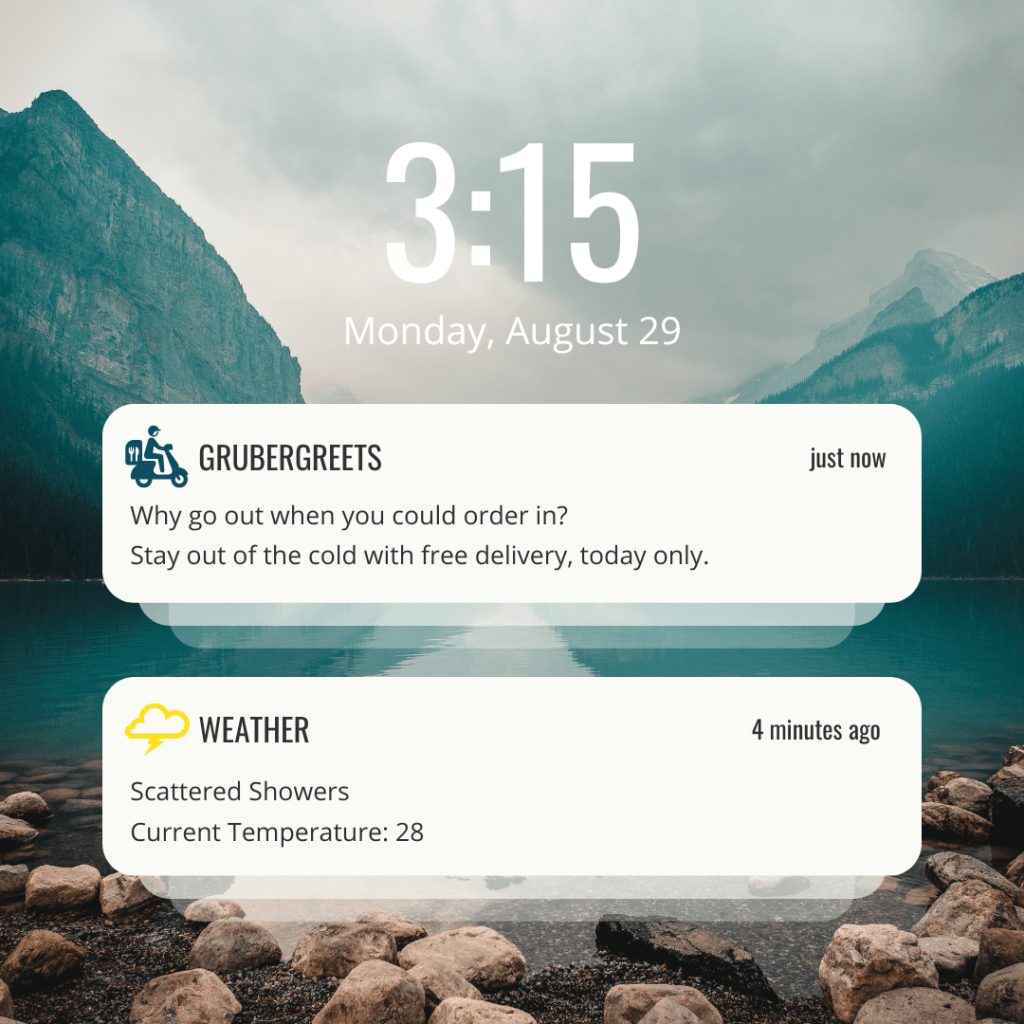
- Create and optimize a Google Business Profile (GBP) for each target territory. This will allow you to attract customers using “near me” or local-based keywords.
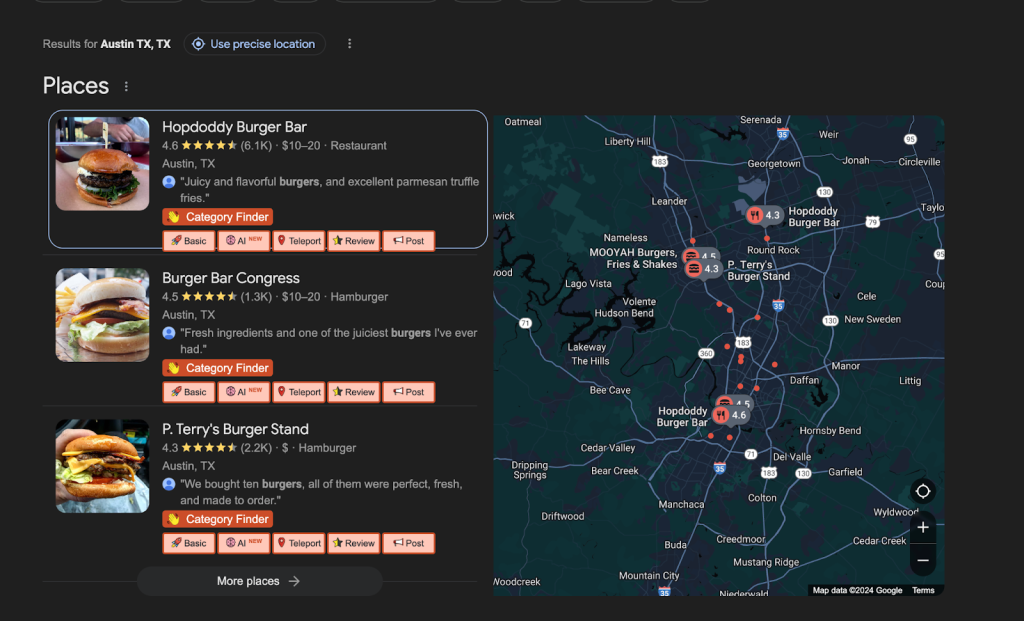
- To geotag at the country level, tailor your ad content (and website) to match the country’s dominant language. For example, if you have franchisees in France, it’s best to serve ads in French instead of English.
- Customize your service or product offerings to match the local culture and preferences. For instance, Dunkin’s Donuts tailors its menu based on the location. In Indonesia, they offer a mochi waffle donut that combines the traditional mochi with a waffle texture and a Lotus Biscoff biscuit donut in their Switzerland location.
- Use geofencing to reach new customers who visit your target location. Geofencing is another type of location-based technology that allows businesses to set up virtual boundaries around a specific physical area. This can be stores, events, or even landmarks.
So whenever a potential customer enters this geofenced area, they receive targeted ads, notifications, or promotions directly on their mobile devices. See this example from Starbucks:

2. Use UGC to Incite Customer Interest:
UGC (or user-generated content) refers to any content customers create to show their experience with a brand. This can include:
- Photos and videos shared on social media
- Podcasts
- Unboxing blogs on YouTube and Instagram
- Reviews and testimonials, etc
At its core, UGC influences brand perception because it relies on a powerful marketing psychology: trust. With UGC, your marketing feels like a genuine experience, not another sales ad.
Sugar Factory is a brand that uses UGC to advertise its restaurant and reach more customers. According to Tom Recine, Sugar Factory Partner, it’s primarily because of their eye-catchy meals:
“…pretty much every table will have their camera out because they see something they think is fantastic.”
Because of their customer-centric and Instagrammable approach, they made it easy for customers to become active brand advocates.
What to do:
- Create a hashtag campaign to encourage customers to share their experiences with your brand on social media. For example, Starbucks invited customers to decorate coffee cups and share their designs using the hashtag #WhiteCupContest.
In return, the customers can print their designs on a reusable cup and win a $300 gift card. It was one of their most successful UGC campaigns:

- Create a customer loyalty reward program to encourage customers to advocate for your brand. Recent research shows that 75% of customers favor a brand with a loyalty program. See this example from UberEats:
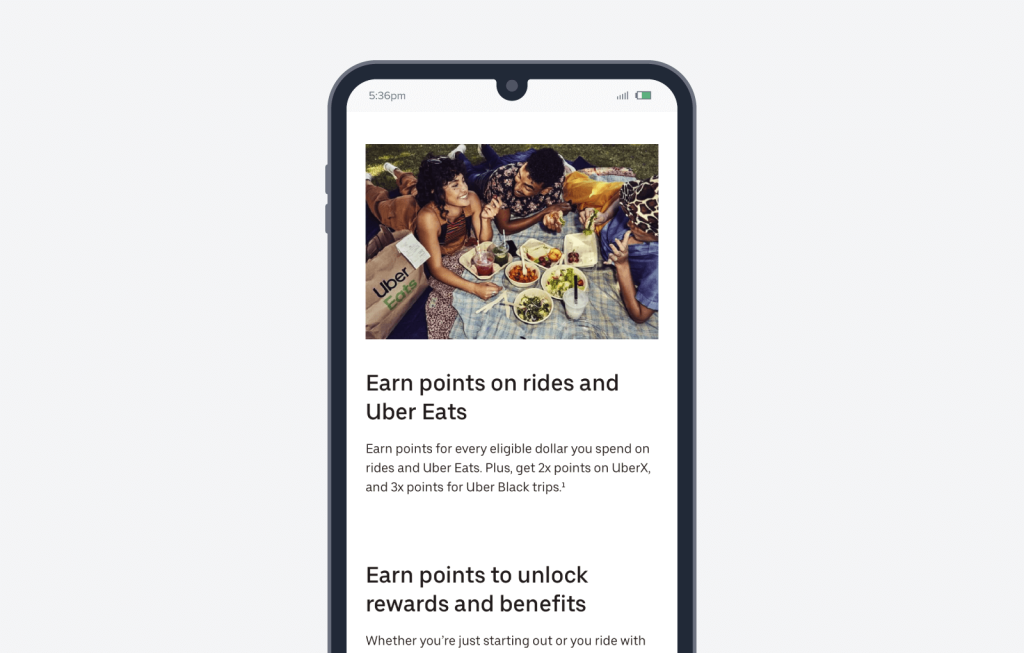
3. Study the Competitor’s Strategy
Before you set out to launch your campaigns, you need to study the competition. Chances are that you’re not the only brand offering your product/service at the local level. Assessing the competition can help you know what you’re up against and how to tighten your belts for success in each territory.
What to do:
Before you start the search, find out who your main competitors are, i.e., brands with similar product/service offerings. Are they operating a franchise business model or just a local brand? If they use the franchise model, you’d also want to note down their own locations compared to yours.
Run a quick search on Google for your primary keyword + location to find your direct competitors:
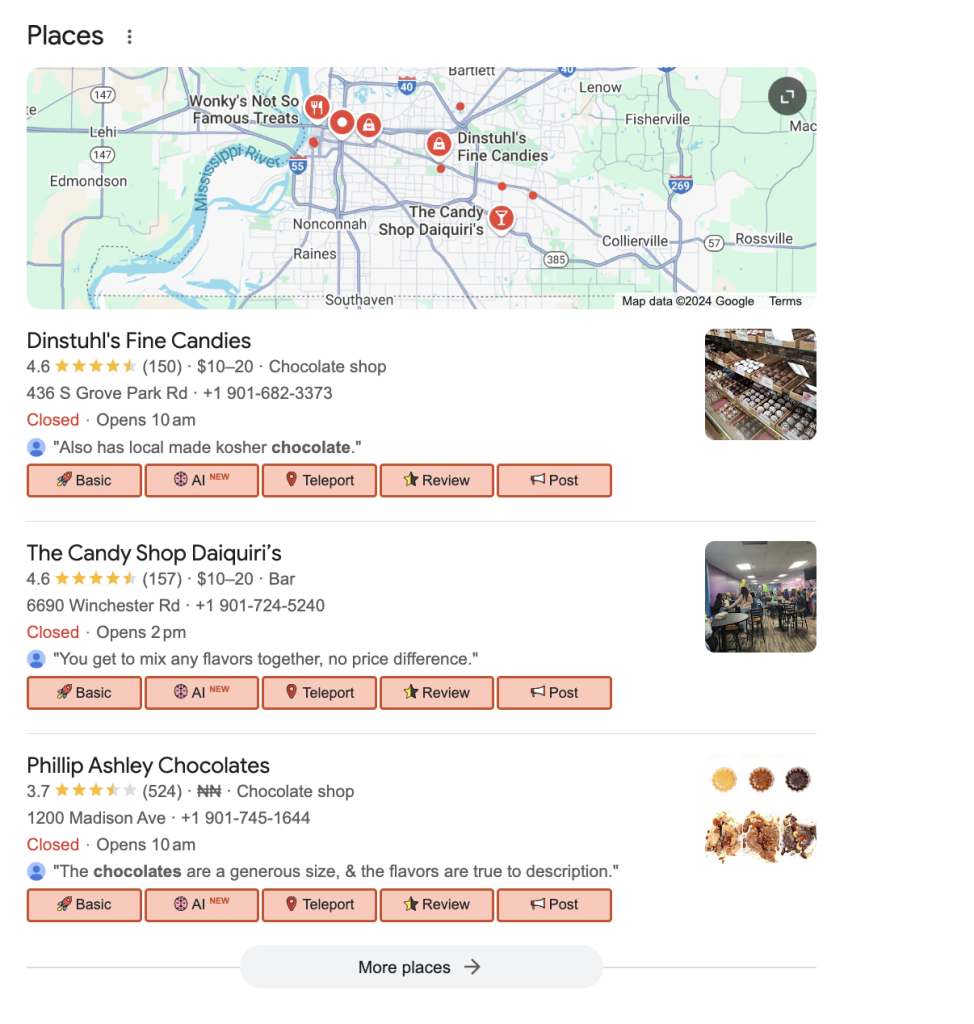
Look at the names that pop up. If you notice any household name, there’s a high chance that they’re operating the franchise model. For instance, in the image above, Dinstuhl’s Fine Candies is a multi-location business with stores in 5 cities in Tennessee. The other brands listed (the Candy Shop Daiquiri and Philip Ashley Chocolates) have only one store in Memphis.
Next, compile a list of the names in a spreadsheet, an overview of their business models and pricing strategies, what they excel at (strengths), and where they fall short (weaknesses).
Also, take a look at their marketing strategy. How are they marketing their business? SEO? Social media? PPC? Evaluate their content marketing strategy as well to understand their brand tone of voice and how customers respond.
For example, if you notice that the competitors focus on blogging, this can be an opportunity to dominate social media and drive more organic social traffic to your site.
This data helps you understand how you compare (for each territory), the areas you need to improve, and the opportunities you can capitalize on to take a portion of the market share.
4. Use Social Media For Targeted Advertising
Social media is a great way to increase brand awareness, connect with customers, and generate more sales. Don’t take my word for it. According to statistics, there are over five billion social media users worldwide. Putting that into perspective, that’s approximately 14X the entire population in the US!
Adam Heitzman, the managing partner at HigherVisibility, adds some context:
“Social media can be used for anything from talking directly with customers, solving support issues, driving sales or leads, or just creating great posts that engage your target market. For your franchisees, this is one channel that is very easy to run. But like others, it needs maintenance, consistency, and branding.”
Large franchises like McDonalds, Burger King, Sephora, etc., use social media to engage with their local community and increase revenue. What’s even better is social media advertising. With social media, you can run targeted social media ads to amplify your reach and revenue. Also, it allows you to take advantage of the targeted capabilities of the platforms to reach your potential customers.
For example, Facebook allows you to target audiences based on their past engagement, demographics, and interaction with your content, including the likelihood of success. On LinkedIn, you can streamline your campaign only to show audiences within a particular region or the number of connections or employees in a specific organization.
This laser-focused hyper-targeting option helps you maximize ad spend and ensures you only attract clicks that matter for your franchise locations.
What to do:
- Set clear and detailed guidelines for social media across all territories. Be sure to include the relevant brand assets (color, tone, logo, fonts, etc.), content types (promotional offers, community events, etc.), engagement guidelines, and posting frequency.
- Create and share content that resonates with the local community where you have a brand presence. This can be an ad offering discounts for a festival or regional event.
- Collaborate with complementary brands and influencers in each territory to drive awareness and reach more customers.
- Utilize the hyper-targeting capabilities of the social media paid ads channels to connect with your ideal customers.
- Create a customer reward program to encourage customers to share their experiences with their network, online or offline. For example, each franchisee can promote an image ad showcasing a customer testimonial after visiting the walk-in location.
5. Create A Local SEO Strategy To Reach Nearby Customers
Local SEO works. When it comes to franchise marketing, it’s even more important (and effective).
“Local search engine optimization is one of (if not the most) important facets of franchise marketing,” Adam said. “When someone searches on Google for a local business, you need your franchisee’s locations to display immediately. If they don’t, the odds of them getting the sale and securing business drop dramatically. And that impacts both the franchisor and the franchisee for income and growth.
Research from Google shows that 4 out of 5 customers conduct searches with local intent. And 76% of these customers visit the business within a day. Without optimizing each territory for local SEO, you’ll miss out on the traffic actively searching for local businesses nearby.
What to do:
- Create and optimize the GBP for each location. Why is this important? Whenever a user searches for a product/service on search engines like Google, the algorithm automatically renders the top three optimized GBPs (the map pack) based on proximity to the searcher’s location, relevance, and prominence (reputation).
According to Google, the local map pack attracts 44% of the total clicks on the search results!
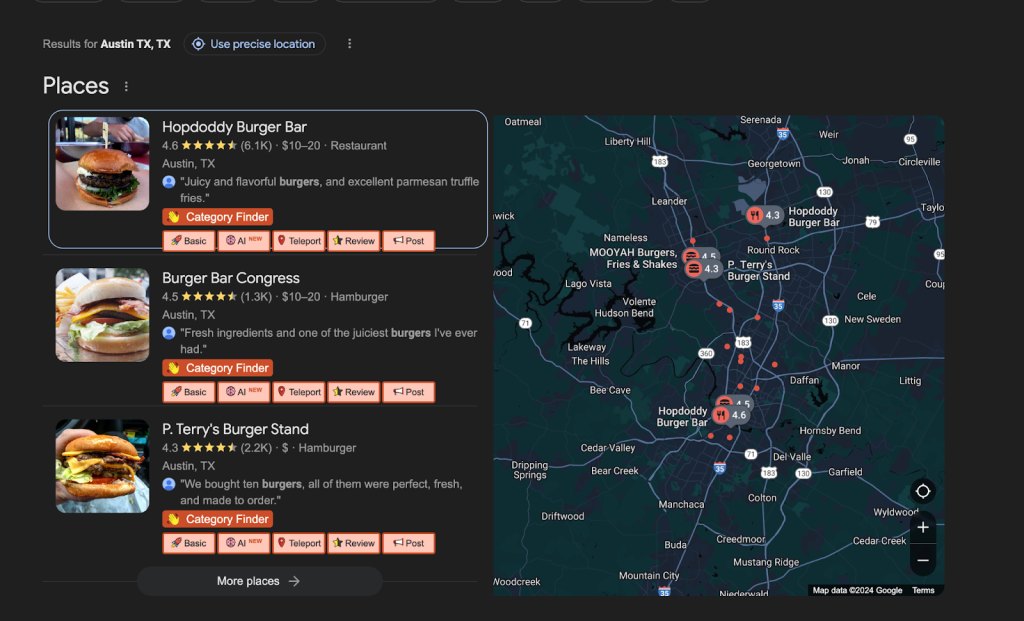
- Create location-specific landing pages for each franchise location on the website. These pages should include local content that reflects each location’s specific services or products.
For example, Roto-Rooter created location-specific landing pages for all their regions and optimized them for their local keywords respectively. The H1 for the Hawaii location is “Find a Plumber in Hawaii.” They also added other local keywords in the content, like “Expert Hawaii Plumbing Services” and “Hawaii Plumbers,” to showcase local relevance and avoid competing for similar keywords across locations:
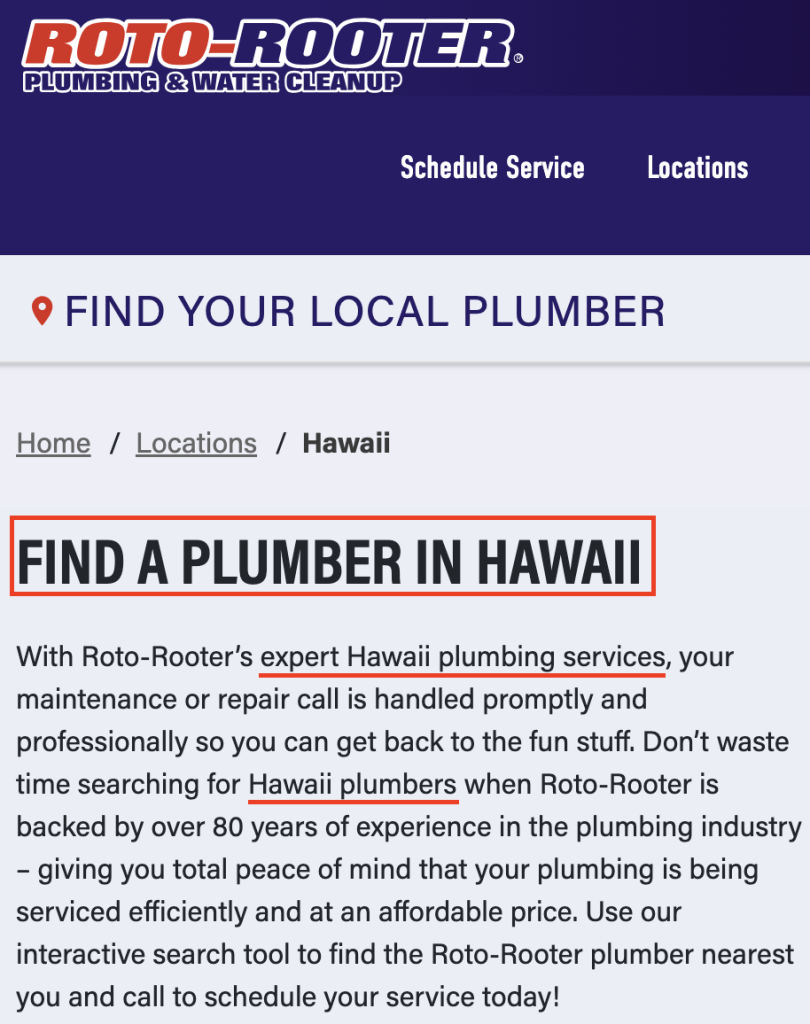
- Also, for each page, target and incorporate localized keywords that (potential) customers are using to find services in their area into the website content, blog posts, and social media updates to increase local search rankings.
- Build relevant local citations to increase authoritativeness and trust for each location.
- Encourage local customers to write reviews and testimonials on your GBP. You can display these testimonials on your location landing pages.
Read more: Local SEO for franchises.
6. Create a Targeted Content Marketing Strategy
A targeted content marketing strategy focuses on creating content that appeals to a (very) specific audience segment by addressing their needs and pain points at each stage of their journey. This content strategy helps prevent duplicate content issues between franchisees and the franchisor.
Adam confirms this:
“Setting up websites for every franchisee can lead to competition issues for similar content ideas and keyword searches. I.e, duplicate content issues and competing against your own franchisees. For instance, both the franchisor and franchisee would be competing for articles about DIY bed bug treatments. This can lead to burdensome maintenance and even penalty issues with Google.”
What to do:
Creating a targeted content strategy requires in-depth market research for each location to understand customers’ needs, pain points, and purchase patterns.
Adam recommends to:
“To generate ideas, look at common keywords that your customers are searching for. If you have Google Analytics established, you can look at the on-site search report for starter ideas. This report shows what people are searching for directly on your site. You can quickly turn these into information blog posts on your website.”
Also, you can create localized content (blog posts, social media content, etc) that reflects local culture and events. For example, adding location-specific messaging, landmarks, and testimonials to showcase relevance.
Incorporate location-specific keywords in your web content to differentiate your website content and avoid competing for the same keywords across locations. For instance, let’s assume you have franchisees in the same region but different cities:
Franchise A: Optimize for “Plumbing and HVAC in Nashville”
Franchise B: Optimize for “Plumbing and HVAC in Jackson City”
This is the exact strategy we used for Caliber Collision, the largest collision repair company in the US. When they came to us, they wanted to optimize their individual landing pages and increase rankings for their primary keywords.
For their on-page strategy, we focused on creating keyword-rich, hyper-local content for each location page. Also, we improved their navigation and site architecture so that search engines can crawl and index their pages faster. After this campaign, they saw a:
- 28.04% increase in organic traffic
- 141.51% increase in goal conversions
- 196% increase in top keyword rankings.
Here’s what the Chief Marketing Officer at Caliber Collision, Greg Clark, said after the campaign:
“HigherVisibility has delivered nothing but exemplary results since taking over Caliber Collision’s SEO account. Since taking over our account, HigherVisibility increased Caliber’s organic conversions by 141% along with vaulting Caliber’s website to the top online authority in the collision industry.”
You can read the full case study here.
7. Create a Remarketing and Upselling plan
It’s rare to see online searchers convert after their first visit. The customer journey is even more convoluted if you’re in the B2B or SaaS industry. This is why you need a remarketing and upselling plan.
Remarketing is a strategy that allows you to serve ads or content to users who have visited your website or interacted with your brand but didn’t convert. It incites them to take the desired action (visit your store, complete an order online, or even sign up for your newsletter).
For example, let’s say someone visits your website, checks the menu available at their location, and leaves without placing an order. You can use remarketing ads to reach this customer segment and compel them to convert. This can be through coupons, free deliveries, or a special offer that feels too good to be true (to create the “Fear Of Missing Out” effect).
Upselling, on the other hand, is a sales technique where you persuade customers to buy a more expensive or upgraded item different from what they intend to purchase. In this case, your “upselling” offer looks like a better deal or more valuable than providing more value in the minds of your customers. As a franchisor, it’s a great way to drive sales and increase revenue without appearing (too) salesy.
What to do:
- Use dynamic ads to display personalized ads based on the user’s experience with your brand. For example, Amazon shows ads for products users previously viewed to recapture their interests.
- If you don’t have an email list yet, install a lead form on your website to collect contact information from users whenever they click through. Then, send email newsletters advertising special offers or free deliveries to encourage conversion.
- Create compelling upsell offers that users cannot refuse. For example, you can create a combo deal for two frequently-bought products.
8. Use Email And Sms Marketing To Re-Engage Customers
Email and SMS marketing also help to re-engage customers who have shown interest in your brand or become inactive. They’re also a great way to:
- Maintain relationships with customers across all locations
- Encourage customer loyalty (remember, people buy from people they trust)
- Compel customers to purchase even when they didn’t plan (e.g., Sending promotional offers with limited time.)
Why does this work? Let’s explore a few statistics:
- Email marketing has an open rate of 46-50%, and SMS has a rate as high as 98% (combined, they are a powerhouse!)
- 72% of people made a purchase after receiving a brand’s text message. In 2023, 52% of customers made a direct purchase from an email they received.
- Every $1 spent on email marketing yields an impressive ROI of 3600%!
As a franchisor, email and SMS marketing for your brand requires a different approach than traditional marketing. While you want to generate the most ROI from your email and SMS campaigns, you also have to ensure that the franchisees adhere to the corporate compliance guidelines, send personalized emails to customers, and are consistent in messaging.
What to do:
- Develop email and SMS marketing campaign templates to keep branding consistent across all locations. This includes the event announcements, promotional images (and videos), etc. For example, to increase the chances of success, it’s important that the emails and texts are succinct yet engaging enough to incite a click-through.
- Establish a framework that includes all your brand core messages, tone of voice, content style, and off-limits phrases. Be sure that all the franchisees understand what and how to communicate across all platforms, including SMS and emails.
- Create case studies or ad samples of successful email and SMS marketing campaigns you’ve held in the past or from other locations. This can serve as a roadmap for other franchisees when sending customers emails and texts.
- Some locations have stricter data privacy laws than others, so ensure you outline all the legal and regulatory requirements the franchisees must follow. This includes opt-in/opt-out requirements, compliance with local and national laws, guidelines for obtaining customer consent, etc.
- Use SMS and email marketing automation tools, such as ActiveCampaign, Klaviyo, Mailchimp, Sender, etc., to build an automated workflow and send relevant customized messages to your customers.
- Integrate your email and SMS marketing into your marketing stack to create a comprehensive omnichannel strategy. This unifies your brand messaging and reduces issues like fragmented customer experience or conflicting information.
- Provide a detailed report on the critical KPIs (key performance indicators) and metrics the franchisees should track. This will help them analyze which strategies impact the bottom line and which need improvement.
Conclusion
As you can see, marketing a franchise business is trickier than marketing a standalone business. Without a solid plan, you risk losing control of your brand’s core values and consistency across different locations. Once this happens, it may not be easy to regain customer trust, as the inconsistencies can lead to a fragmented brand image.
To avoid this, bring in franchise marketing experts to create a customized marketing plan to market your corporate business and attract more customers for your franchisees.
At HigherVisibility, we’ve helped several franchise companies scale their marketing efforts at corporate and franchisee levels. As a leading franchise marketing company ourselves, we have first-hand experience creating and implementing a marketing strategy for franchise locations.
